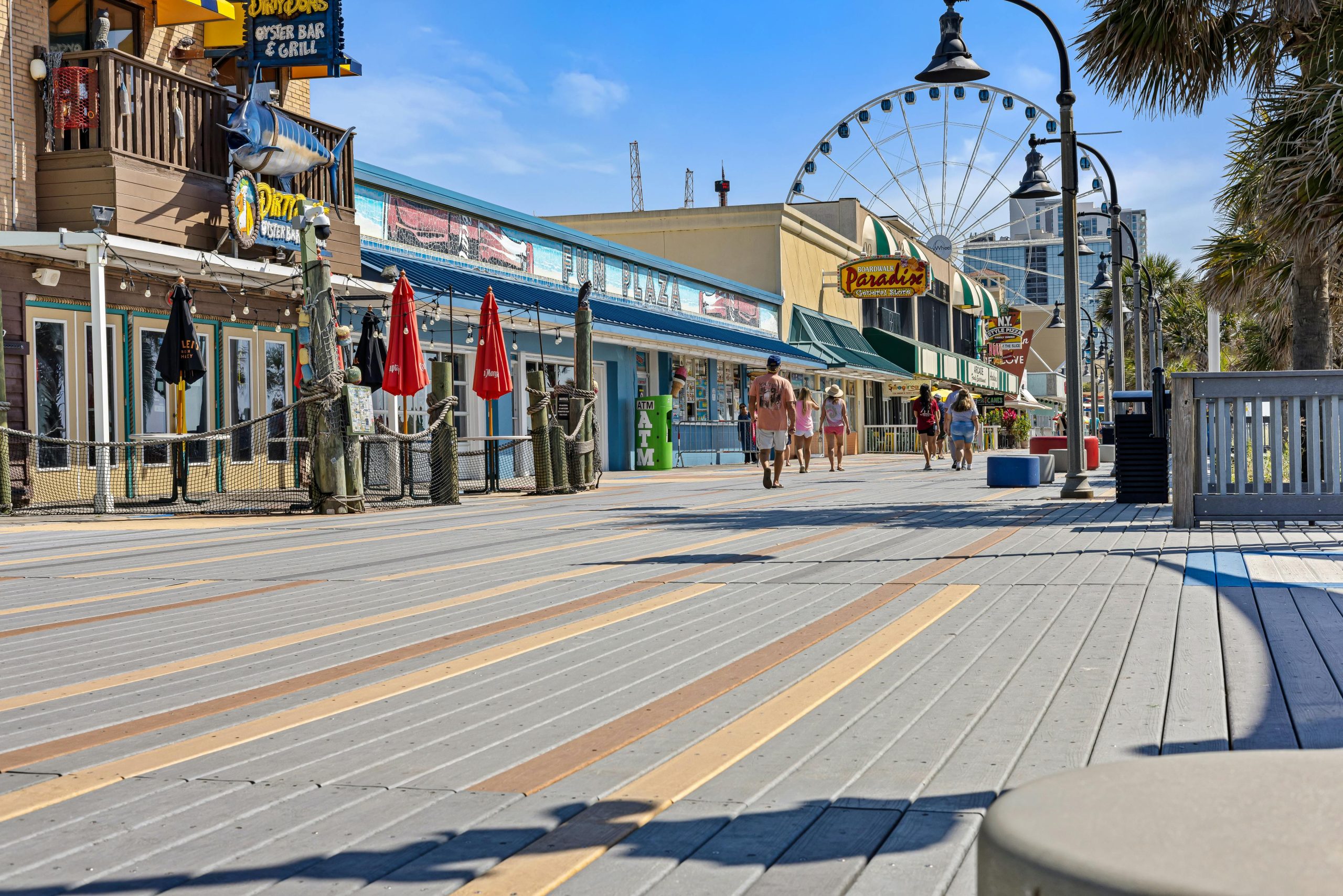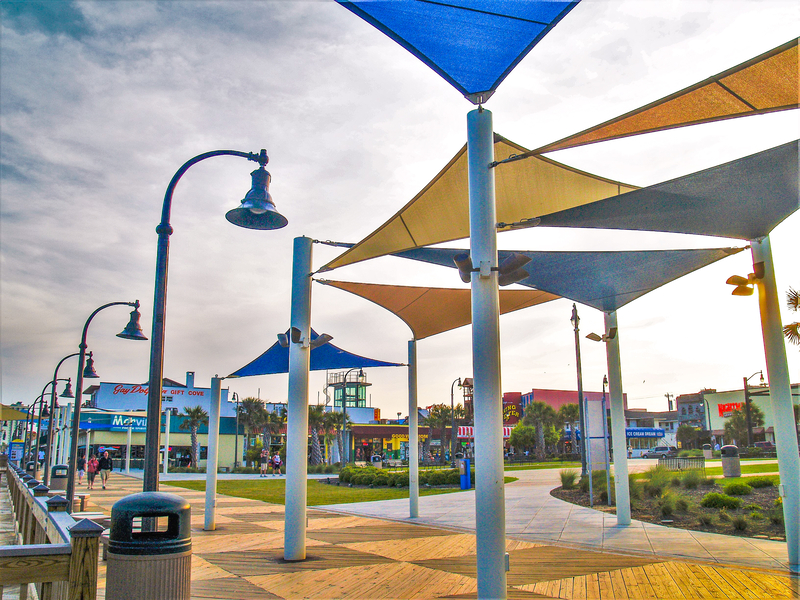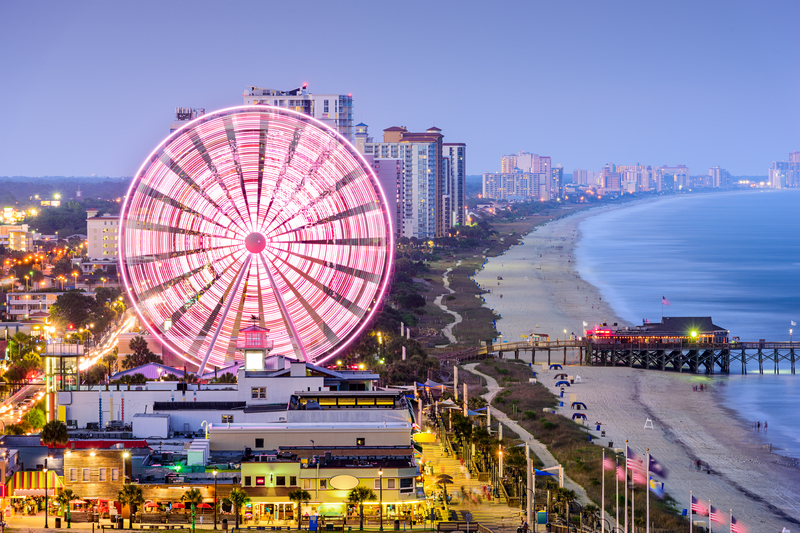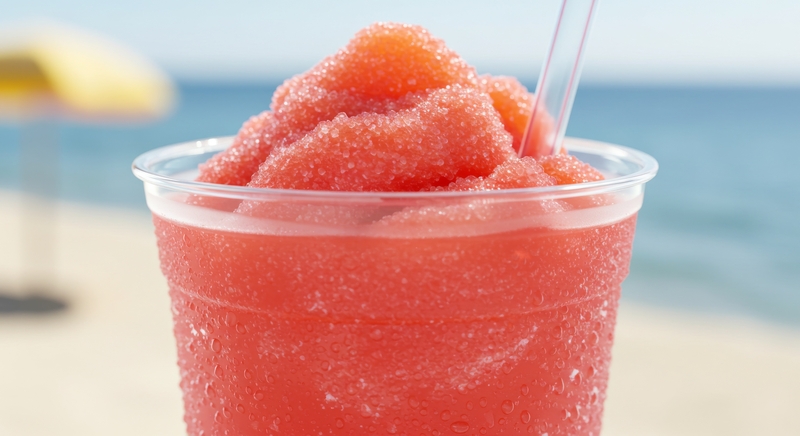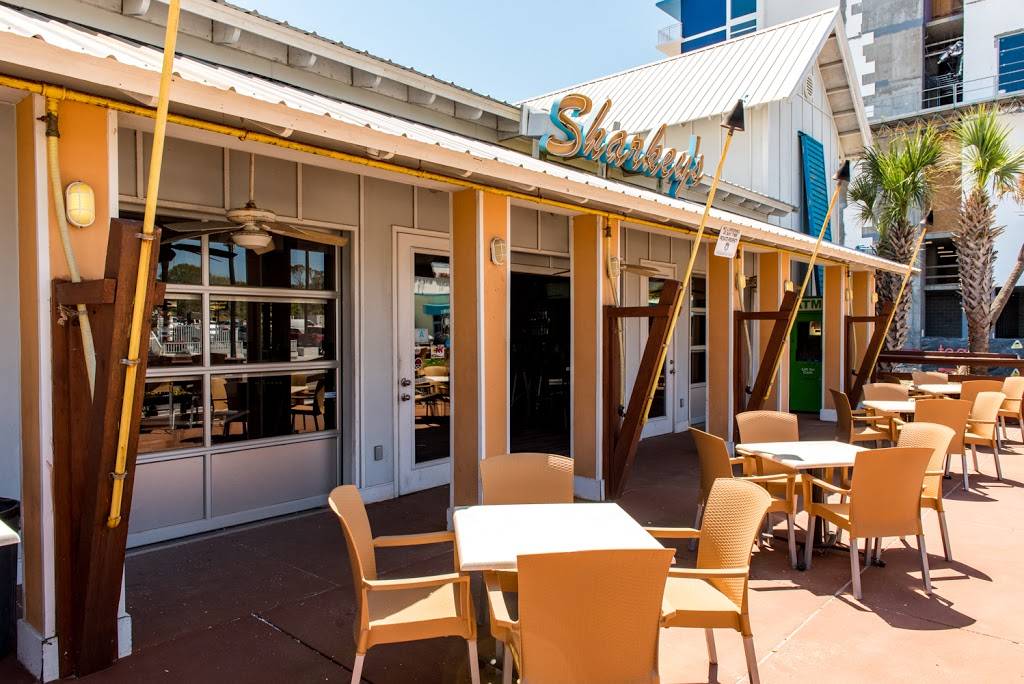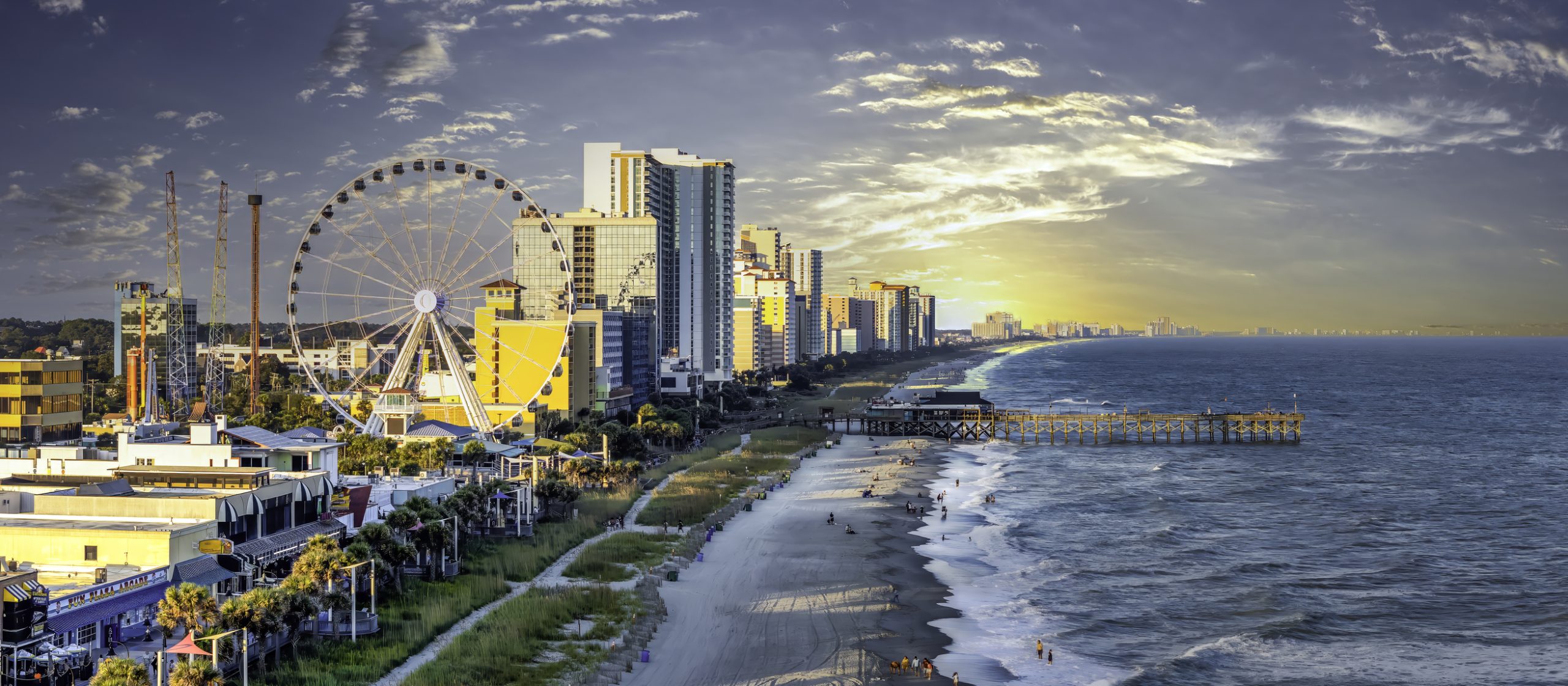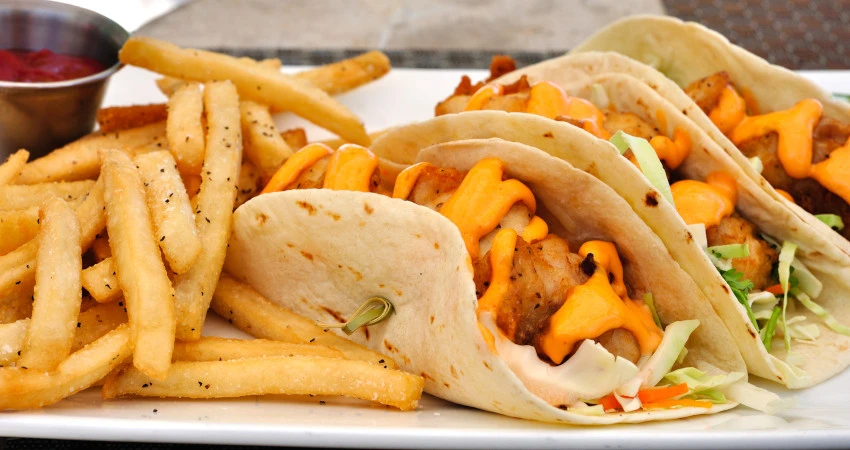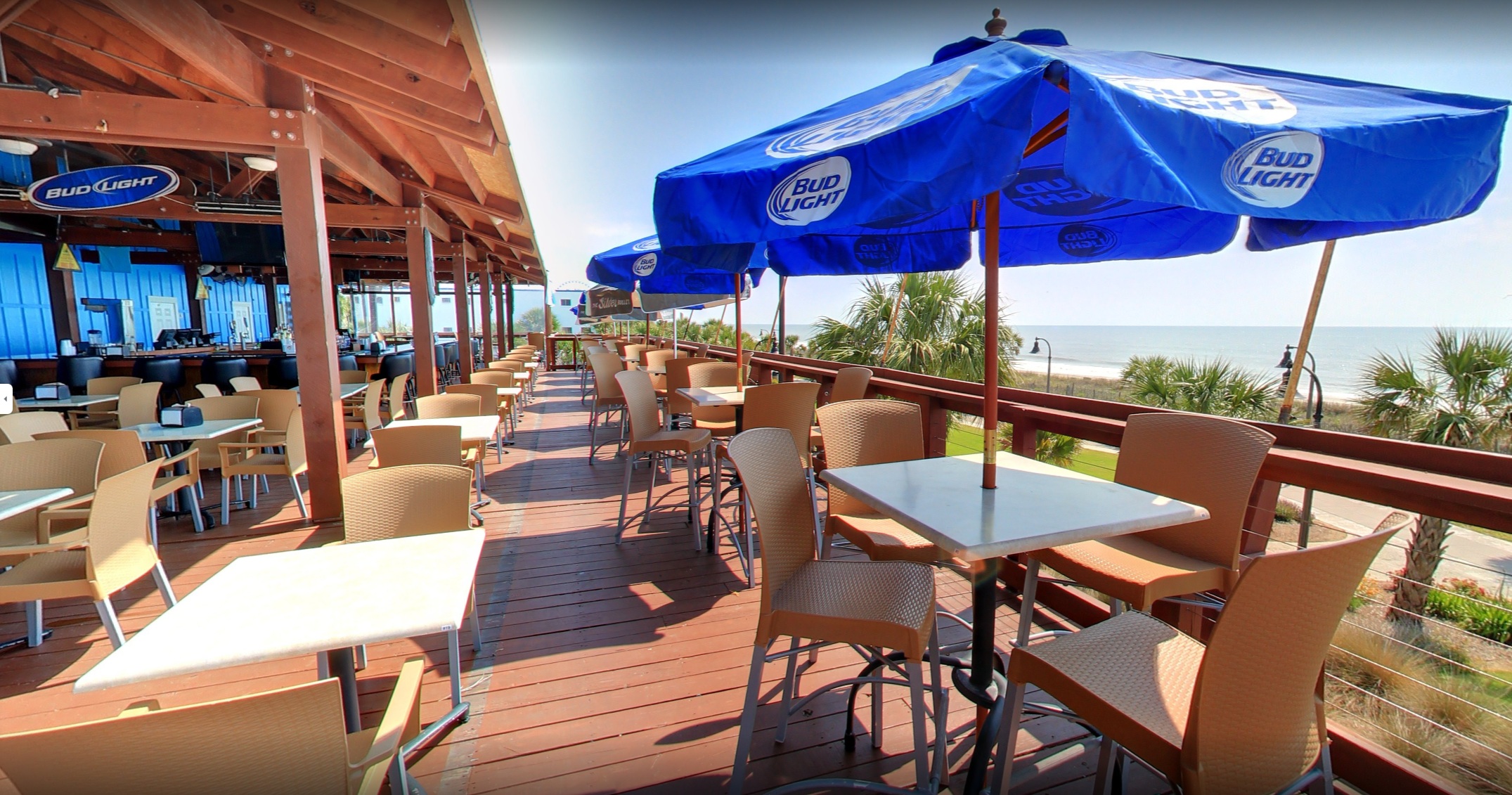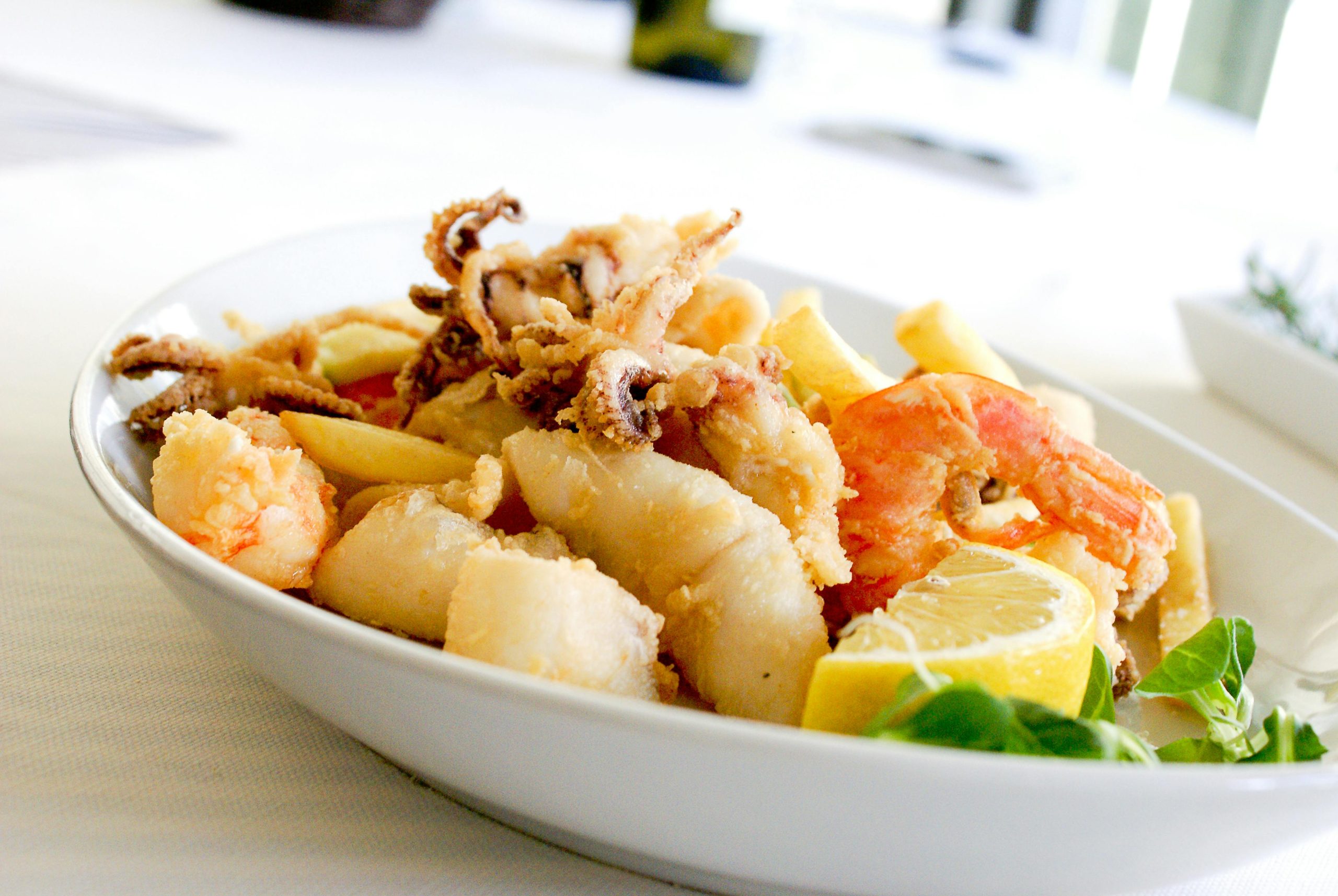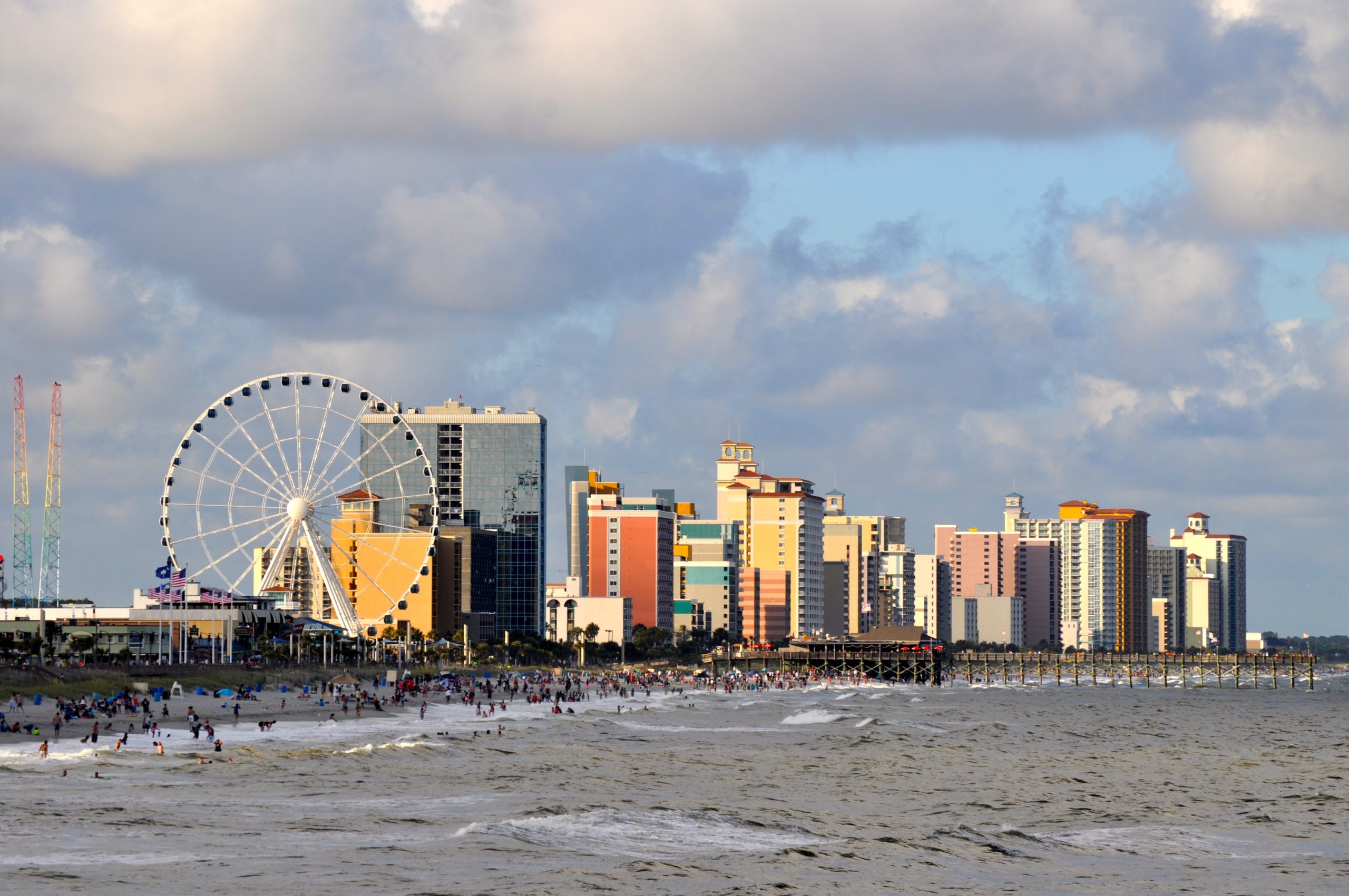Look, we’ve all been there. You’re checking the weather app every five minutes, watching those rain clouds roll in, and wondering if your beach day is toast. But here’s the thing about Myrtle Beach—the boardwalk doesn’t shut down just because the sun takes a day off.
Actually, some of my favorite memories here happened on drizzly days when the crowds disappeared and we had to get creative. So if you’re staring out at gray skies right now, take a breath. Your day isn’t ruined. It’s just going to look a little different than you planned.
Hit Up the Arcades (Because Why Not?)
There’s something oddly perfect about ducking into an arcade when it’s pouring outside. The boardwalk has a couple of gems that’ll transport you straight back to childhood—or at least give your kids something to brag about.
Fun Plaza is the real deal if you love that old-school arcade atmosphere. We’re talking skee-ball, air hockey, and those coin pusher games that are way more addictive than they should be. No fancy graphics or VR headsets—just pure, simple fun.
And you can’t skip the Gay Dolphin Arcade, especially since it connects to the Gift Cove. Fair warning: once the kids start racking up tickets, you might be there longer than you think. But honestly? That’s not the worst problem to have on a rainy afternoon.
Browse Without the Pressure
Rain gives you permission to slow down. Instead of feeling like you need to maximize every minute of sunshine, you can actually wander into shops without that nagging voice saying you should be on the beach.
The Gay Dolphin Gift Cove is worth at least half an hour, maybe more if you’re into quirky finds. It’s been around forever and has this delightfully chaotic charm—shark teeth jewelry, seashell everything, random coastal decor you didn’t know existed. The kind of place where you go in for a keychain and come out with a hand-painted sign for your bathroom.
The other boutiques and surf shops along the boardwalk are mostly covered or indoors anyway, so you can hop between them without getting soaked. And honestly, there’s zero pressure to buy anything. Sometimes just looking is enough.
Walk in the Rain (Hear Me Out)
I know this sounds counterintuitive, but if you don’t mind getting a little damp, the boardwalk is actually beautiful in the rain. Throw on a poncho or grab an umbrella, and you’ll have the place mostly to yourself.
The ocean looks completely different when it’s gray and moody. The sound of rain hitting the water, the cool breeze, the lack of crowds—it’s almost meditative. There are covered spots and benches along the way if you want to stop and just watch for a bit.
It’s surprisingly romantic if you’re here with someone special. And if you’re solo? It’s one of those rare moments where you can actually think without a thousand distractions.
Duck Into Something Weird and Wonderful
The boardwalk area has enough indoor attractions to fill an entire rainy day, and some of them are genuinely entertaining—not just “killing time until the sun comes out” entertaining.
Ripley’s Believe It or Not! Odditorium is the perfect rainy day move. Hundreds of strange exhibits, optical illusions, and interactive stuff that’ll keep everyone entertained. It’s weird in the best way possible.
If you want something more high-energy, try the Ripley’s 5D Moving Theater. It’s basically a ride without the roller coaster—your seat moves, you feel wind and water, the whole sensory experience. Kids love it, and adults usually end up laughing just as hard.
The Mirror Maze is another good option, especially if you have competitive family members who think they won’t get lost. (Spoiler: they will.)
And if you’re traveling with a group, there are escape rooms nearby that can turn a dreary afternoon into a shared adventure. You might actually forget it’s raining outside.
Grab a Seat With a View
Here’s where I’ll be honest—when it rains, we don’t run away from the ocean. We just move under cover.
Sharkey’s has been my go-to on days like this. The covered patio and indoor seating give you those ocean views without the downpour, and there’s usually live music to keep things lively. Order something good—fresh seafood, a cocktail that tastes like vacation—and just let the afternoon unfold.
It’s one of those places where you realize the rain didn’t actually ruin anything. You’re still on the boardwalk, still watching the waves, still on vacation. Just drier than you would’ve been.
A Few Things That Actually Help
Bring a light rain jacket or poncho. Weather changes fast here, and staying reasonably dry makes everything more enjoyable.
Let go of the plan. Your beach day became an arcade day? Cool. That’s still a good day.
Don’t hide in your hotel room. Seriously. The boardwalk is still happening, rain or not. You’ll kick yourself later if you spend the whole day watching TV.
The Bottom Line
Rain doesn’t erase Myrtle Beach—it just changes the channel. You might discover an arcade game you’re weirdly good at, find the perfect souvenir in some tucked-away shop, or have one of those unexpectedly perfect meals where everything just clicks.
The boardwalk keeps going no matter what the weather does. And sometimes, the days that don’t go according to plan end up being the ones you talk about for years.
So grab your umbrella, see what’s happening out there, and give the rain a chance. You might be surprised.
When you’re ready to dry off and refuel, we’re here at Sharkey’s with good food, cold drinks, and an ocean view that doesn’t quit—rain or shine.
There’s something timeless about a good boardwalk. It’s where salty ocean air meets the buzz of local life, where beachgoers wander barefoot with ice cream cones, and where the horizon seems to stretch on forever. And in Myrtle Beach, South Carolina, the boardwalk isn’t just a path—it’s an experience.
Whether you’re here for a family vacation, a romantic getaway, or just looking to stretch your legs somewhere beautiful, the Myrtle Beach Boardwalk might just be the best place to take a beachfront stroll.
Scenic Views from Sunrise to Sunset
Early risers are in for a real treat. If you start your day on the boardwalk just as the sun begins to rise over the Atlantic, you’ll catch one of the most peaceful scenes Myrtle Beach has to offer. The beach is still quiet, the crowds haven’t arrived yet, and the warm light hits the water in all the right ways.
As the day rolls on, the boardwalk transforms. The bright colors of shops and arcades pop against the blue sky, and the constant breeze off the ocean keeps things comfortable, even in the heat of summer. In the evening, sunset walkers get a different kind of magic—the golden glow behind the SkyWheel, the sounds of street performers, and the buzz of beachgoers winding down.
Perfect for People-Watching (and Seagull-Dodging)
If you enjoy observing the rhythm of everyday life in a beach town, the Myrtle Beach Boardwalk is a front-row seat to it all. It’s like a moving postcard—families pulling wagons stacked with beach chairs and coolers, kids giggling as they chase bubbles or lick ice cream faster than it can melt, teens lined up at arcades trying to win a prize, and vacationers soaking in the sun with that unmistakable “we’re finally on break” energy.
You’ll likely see a street performer or two—maybe a guitar player crooning classic tunes, a sand sculptor turning a pile of grains into art, or someone showing off a surprisingly good magic trick that draws a little crowd. It’s the kind of place where everyone’s in a good mood, and that vibe is contagious.
And while you’re soaking in the scene, don’t forget to keep one eye on your funnel cake or french fries. The local seagulls are bold and opportunistic—they’ve perfected the art of the snack snatch. It’s all part of the fun, though, and spotting them circling overhead or perched on lampposts just adds to the boardwalk’s coastal character.
Smooth, Wide, and Accessible
One of the things that sets the Myrtle Beach Boardwalk apart is how truly welcoming it is to everyone. It’s more than just a scenic walkway—it’s built with comfort and accessibility in mind.
The boardwalk is wide enough for foot traffic to flow naturally, whether you’re walking hand-in-hand, pushing a stroller, or using a wheelchair or mobility aid. There’s no battling for space or dodging potholes—just smooth wooden planks that make it easy to enjoy the views without watching your step every second.
You’ll find plenty of thoughtful touches along the way: benches for resting tired feet, shaded nooks to cool off from the sun, and clean public restrooms that are surprisingly convenient. The boardwalk is also lined with gentle ramps and beach access points, so you can pop down to the sand or return to the shade without any hassle.
Whether you’re taking a slow walk with your grandparents, navigating a toddler’s boundless energy, or just looking for a place to unwind with minimal effort, the boardwalk’s layout makes it easy to enjoy the moment. It’s designed not just for looking at the beach—but for being part of it.
Photo Ops at Every Turn
If you’re someone who likes to capture memories (or boost your social media feed), this boardwalk has a lot to offer. The Myrtle Beach SkyWheel makes for a fantastic backdrop, especially in the evening when it lights up with neon colors.
There’s also a historic pavilion section, oceanfront gardens, and vibrant storefronts that make even casual snapshots look vacation-worthy. And if you’re lucky, you might even catch one of the seasonal festivals or fireworks displays that light up the sky over the beach.
A Little Romance Along the Way
For couples, the boardwalk sets the scene for a slow, scenic walk hand in hand. There’s something about the mix of ocean breeze, soft lighting, and the sound of waves rolling in that brings out the romantic in just about everyone.
You’ll find a few quiet corners tucked between the livelier attractions—ideal for catching a moment alone or snapping a sweet photo together with the ocean in the background.
Where to Wrap Things Up: Sharkey’s Oceanfront Restaurant
By the time the sun starts to sink, you’re probably ready to sit down and relax—and Sharkey’s Oceanfront Restaurant is one of the best ways to close out your walk. Just steps from the sand, Sharkey’s pairs ocean views with a lively atmosphere, coastal cocktails, and fresh seafood.
Whether you’re in the mood for a sunset drink on the upstairs patio or a hearty dinner to satisfy a boardwalk-sized appetite, it’s the perfect spot to kick back and soak in the evening. And because it’s so close to the action, you won’t miss a beat—you can hear the waves, see the boardwalk lights, and feel that breezy energy that makes Myrtle Beach so unforgettable.
Final Thoughts
Some places just feel like summer, and the Myrtle Beach Boardwalk is one of them. It’s not just a strip of wooden planks along the sand—it’s a hub of local charm, a place for slow walks and sweet treats, for people-watching and ocean-gazing. Whether you’re walking solo at sunrise or with family in tow at sunset, it’s a memory in the making.
And when you’re ready to call it a day? Grab a drink, a view, and a seat at Sharkey’s. You’ve earned it.
Stretching 1.2 miles along South Carolina’s pristine coastline, the Myrtle Beach Boardwalk isn’t just a walkway—it’s the beating heart of the Grand Strand. From the moment the sun paints the Atlantic in golden hues to the neon-lit excitement of summer nights, this iconic destination delivers memories that last a lifetime.
Whether you’re planning your first visit or rediscovering this coastal gem, here’s your guide to making the most of every moment on the Boardwalk.
Start with the Magic Hour: Sunrise at 2nd Avenue Pier
Early risers are rewarded with one of the most breathtaking experiences the Grand Strand has to offer. The 2nd Avenue Pier, located at the southern end of the Boardwalk, provides an idyllic place to enjoy a nice stroll on the pier and one of the best sunsets in Myrtle Beach (and equally stunning sunrises).
Built in 1936, this 906-foot-long pier takes visitors out into the Atlantic’s depths for unbeatable fishing and expansive ocean views. Arrive around 6:30 AM with your coffee in hand, and watch as the sky transforms from deep purple to brilliant orange. The pier is peaceful at this hour—just you, the waves, and the promise of an incredible day ahead.
Pro tip: Dogs are allowed on the Myrtle Beach Boardwalk between 5:00am and 10:00am from May 1 through Labor Day, making sunrise the perfect time for a walk with your four-legged friend.
Morning Fuel: Breakfast and Coffee
As the Boardwalk begins to stir to life, you’ll find plenty of options to fuel your day. Whether you’re craving classic pancakes or a quick coffee and pastry, the surrounding area offers everything from casual cafes to hearty breakfast spots that have been serving beachgoers for decades.
The Heart of the Action: SkyWheel and Attractions
The iconic SkyWheel Myrtle Beach standing 187 feet tall is impossible to miss as you make your way along the Boardwalk. Standing 187-feet above the ocean waves with far-stretching views along the coastline, the SkyWheel is an iconic attraction that all ages will love. Each gondola is enclosed and air-conditioned, offering comfortable 10-minute rides with panoramic views of the coastline.
Beyond the SkyWheel, adventure awaits:
- Ripley’s Collection: Boardwalk visitors can explore three of the four Ripley’s local attractions: Ripley’s Believe it or Not Odditorium, Ripley’s Haunted Adventure, and Ripley’s Crazy Golf
- Thrill Rides: Free Fall Thrill Park features towering rides, including the Sling Shot, Air Strike, and the Screaming Swing for hours of exciting entertainment
- Family Fun: Multiple arcades offer classic games, from skee-ball to modern gaming experiences with prizes for all ages
Shopping and Souvenirs
No Boardwalk experience is complete without browsing the unique shops that line the promenade. Gay Dolphin Gift Cove is a Boardwalk staple. An iconic attraction and cornerstone of the Boardwalk for over 70 years, this shop carries a diverse selection of apparel, jewelry, collectibles and souvenirs, and seashells.
For beach essentials, Tsunami Surf Shop offers apparel and accessories for everyone. Parents appreciate the practical wares, including towels, resort clothing, sunscreen, and other extras.
The Perfect Lunch Break
Midday calls for refueling, and the Boardwalk doesn’t disappoint. From casual beachside eateries to restaurants with stunning ocean views, you’ll find options for every taste and budget. The key is finding a spot where you can enjoy both great food and the incredible atmosphere that makes the Boardwalk special.
Afternoon Delights: Ice Cream and Ocean Breezes
As the South Carolina sun reaches its peak, treat yourself to something sweet. Local ice cream shops offer the perfect cool-down, with flavors ranging from classic vanilla to creative coastal-inspired concoctions. Find a shady spot along the Boardwalk and watch the world go by—surfers catching waves, families building sandcastles, and the constant, soothing rhythm of the Atlantic.
Golden Hour: Where the Magic Happens
As afternoon melts into evening, the Boardwalk transforms. This is when locals know the best part of the day begins. The crowds thin slightly, the temperature becomes perfect, and the ocean takes on that golden shimmer that makes every photo look like a postcard.
This is the perfect time to discover Sharkey’s Oceanfront Restaurant.
Positioned right on the Boardwalk with unobstructed ocean views, Sharkey’s Oceanfront Restaurant epitomizes the charm of seaside dining. As the sun begins its descent toward the horizon, there’s no better place to grab a cold drink and soak in the atmosphere.
Sharkey’s is celebrated for its signature fish tacos and a diverse array of beverages, making it the ideal spot for happy hour with a view. Whether you choose a frozen cocktail, an ice-cold beer, or one of their signature drinks, you’ll be perfectly positioned to watch the Boardwalk come alive with evening energy.
Dinner with a View
As the sky begins to blush with sunset colors, Sharkey’s transitions seamlessly from happy hour hangout to dinner destination. With a menu that highlights local seafood and crowd-pleasers like fish tacos, grilled mahi, shrimp baskets, burgers, and more, there’s something for everyone.
The restaurant’s laid-back vibe as you spend time with friends or family perfectly captures the essence of coastal dining. Open-air seating lets ocean breezes drift across your table while the sound of waves provides the perfect soundtrack to your meal.
Timing tip: Arrive for dinner just before sunset to witness one of nature’s most spectacular shows right from your table.
After Dark: The Boardwalk’s Electric Energy
Once the sun dips below the horizon, the Boardwalk reveals its nighttime personality. Throughout the summer, the Boardwalk hosts “Hot Summer Nights” with family-friendly activities, fireworks and more. Street performers appear, attractions light up in brilliant colors, and the energy becomes infectious.
Take a leisurely stroll to work off dinner, browse the shops that stay open late, or simply find a bench and people-watch. The nighttime Boardwalk has a magic all its own—part carnival, part coastal paradise.
Special Events and Seasonal Highlights
The Boardwalk calendar is packed with events throughout the year:
- Carolina Country Music Fest: The annual Carolina Country Music Fest is enjoyed each year by locals and visitors from across the country. In 2026, this much-anticipated long weekend of South Carolina beach boardwalk concerts is set to kick off on Thursday, June 4, and run through Sunday, June 7
- Holiday Celebrations: From summer fireworks to winter festivities, there’s always something special happening
- Live Music: Regular concerts and performances keep the entertainment flowing year-round
Planning Your Perfect Boardwalk Day
Best Times to Visit:
- Early morning (6-10 AM): Peaceful sunrise, dog-friendly hours, cooler temperatures
- Late afternoon/evening (4-8 PM): Perfect weather, golden hour lighting, vibrant atmosphere
- The Myrtle Beach Boardwalk is open 24 hours a day, so you can experience its magic anytime
Getting There: The Myrtle Beach area’s 1.2 mile-long Oceanfront Boardwalk and Promenade traverses through the sand from the 14th Avenue to 2nd Avenue Piers. Parking is available, though it’s metered during peak season.
What to Bring:
- Comfortable walking shoes
- Sunscreen and a hat
- Camera for those Instagram-worthy moments
- Appetite for adventure (and great seafood!)
The Boardwalk Experience: More Than Just a Walk
The Boardwalk recently underwent a facelift, now featuring recycled plastic boards in nine colors making it more accessible and more durable for years to come. But beyond the beautiful infrastructure, what makes the Myrtle Beach Boardwalk truly special is how it brings people together.
Families create traditions, couples fall in love with sunsets, friends make memories over shared meals and laughter. It’s a place where the simple pleasure of walking becomes an adventure, and where every visit offers something new to discover.
From the peaceful beauty of sunrise at 2nd Avenue Pier to the vibrant energy of a summer evening, from thrilling rides to quiet moments watching the waves, the Myrtle Beach Boardwalk delivers experiences that define the very best of coastal living.
And when you’re ready to pause, to savor the moment with great food and an even better view, Sharkey’s Oceanfront Restaurant is waiting to welcome you to the perfect seaside experience.
Come for the attractions, stay for the atmosphere, and leave with memories that will bring you back again and again.
Posted by sharkeysadmin
Beat the Heat: Where to Cool Off with a Cocktail on the Myrtle Beach Boardwalk
Summer in Myrtle Beach is electric—sunshine, surf, and endless energy along the coast. The Myrtle Beach Boardwalk buzzes with excitement all season long, from the moment the morning sun rises over the Atlantic to the final sparkle of evening lights. But when the heat kicks in and the sun starts to sizzle, you’ll want to find a spot that offers two things: refreshing drinks and an ocean breeze. That’s where Sharkey’s Oceanfront Restaurant comes in.
Whether you’re strolling the boardwalk, seeking a break from the beach, or meeting up with friends after a long, sun-soaked day, Sharkey’s is the go-to destination to cool off and chill out with a cocktail in hand.
Myrtle Beach Boardwalk: A Summer Must-See
Stretching 1.2 miles along the stunning Atlantic coastline, the Myrtle Beach Boardwalk and Promenade is one of the area’s most iconic summer attractions. It offers everything from live music and family-friendly events to carnival rides, unique shopping, and nonstop people-watching.
But for all its action, one thing’s for sure: the South Carolina sun doesn’t hold back. And as temperatures climb, every smart boardwalk-goer knows to plan their escape from the heat. That’s where a well-timed frozen drink becomes not just a treat—but a necessity.
Sharkey’s: Your Breezy Oceanfront Escape
Located directly on the Myrtle Beach Boardwalk, Sharkey’s Oceanfront Restaurant offers more than just a meal—it delivers a refreshing experience. With an open-air layout, shaded seating, and panoramic views of the ocean, Sharkey’s provides the perfect respite from the sun without stepping too far from the boardwalk action.
Feel that coastal breeze? Hear the waves just beyond the deck? That’s your cue to grab a cold drink and stay awhile.
Sip & Chill: Sharkey’s Frozen Cocktail Favorites
When it comes to beating the heat, Sharkey’s serves up a variety of frozen cocktails that are as Instagram-worthy as they are refreshing. Some customer favorites include:
- Frozen Piña Coladas – Creamy, tropical, and blended to perfection. It’s like vacation in a glass.
- Strawberry Daiquiris – Sweet, icy, and made with fresh fruit flavor—ideal for sipping under the sun.
- Frozen Margaritas – Classic lime or go bold with mango or strawberry twists.
- Sharkey’s Signature Blends – Ask the bartender for the house specials. They’re known for crafting vibrant frozen drinks with fun names and big flavor.
For guests who prefer a non-alcoholic option, Sharkey’s also offers frozen mocktails and smoothies, perfect for kids or anyone looking to stay cool without the buzz.
Perfect Pairings from the Kitchen
Sure, a frozen cocktail can steal the show—but at Sharkey’s, the food is just as cool. The menu is loaded with seafood favorites and beach bar classics that pair beautifully with a cold drink. A few pairing ideas:
- Fish Tacos + Frozen Margarita – A classic duo with tangy, tropical vibes.
- Peel-and-Eat Shrimp + Piña Colada – Sweet, spicy, and perfectly beachy.
- Wings or Sliders + a Cold Daiquiri – For those who like their bite with a little heat and a smooth, chilled finish.
Whether you’re stopping in for a full lunch or just craving a salty snack, Sharkey’s has something to balance every sip.
Ocean Breezes Included
One of Sharkey’s best features? The natural cooling system. Positioned right on the water, the steady ocean breeze and shaded outdoor seating provide a built-in chill zone. It’s not just about escaping the heat—it’s about embracing the atmosphere.
Take a seat at the edge of the deck, watch the waves roll in, and feel the temperature drop (both literally and figuratively) as you enjoy your drink with a view.
Great Vibes for Everyone
Sharkey’s is a welcoming place for:
- Groups of friends catching up over cocktails
- Couples looking for a romantic beachside break
- Families stopping in for a cool-down after a long day at the beach
- Solo travelers enjoying a little “me time” with a view
With a laid-back, come-as-you-are vibe, Sharkey’s is the kind of place that turns casual visits into memorable moments.
Ready to Sip, Chill, and Repeat?
The Myrtle Beach Boardwalk has a lot to offer—but when the sun gets high and the humidity kicks in, don’t just power through it. Make a smart move. Step into Sharkey’s, grab a frozen drink, and let the ocean breeze do the rest.
Whether you’re exploring the boardwalk for the first time or returning for another summer of fun, Sharkey’s is your ultimate cool-down destination. Stop by, sip something tropical, and soak in the ocean views—your chill spot awaits.
Stay cool this summer at Sharkey’s Oceanfront Restaurant—right on the Myrtle Beach Boardwalk!
Stop by for a frozen drink, fresh seafood, and unbeatable views of the Atlantic. Whether you’re strolling the boardwalk or just looking for a laid-back spot to chill, Sharkey’s is your go-to oceanfront escape.
📍 600 N Ocean Blvd, Myrtle Beach, SC
⏰ Open 7 Days a Week | 🍹 Frozen Cocktails Daily
👉 View Our Menu
When summer hits Myrtle Beach, locals and tourists alike flock to the coastline in search of sun, surf, and good times. With so many options available, it can be hard to decide where to spend your afternoons and evenings—but Sharkey’s Oceanfront Restaurant makes that decision easy. Located right on the Myrtle Beach Boardwalk, Sharkey’s offers unbeatable views, fresh coastal cuisine, vibrant drinks, and a laid-back atmosphere that captures everything we love about beach life.
Prime Oceanfront Location
Sharkey’s isn’t just near the beach—it’s right on it. Nestled alongside the bustling Myrtle Beach Boardwalk, this oceanfront restaurant gives you panoramic views of the Atlantic from nearly every seat. Whether you’re enjoying lunch with family or sipping cocktails with friends as the sun dips below the horizon, you’re guaranteed a front-row seat to all the beauty Myrtle Beach has to offer.
And thanks to its location, Sharkey’s is just steps away from some of the area’s top attractions. Whether you’re spending the day riding the Myrtle Beach SkyWheel, browsing beach shops, or enjoying live music on the boardwalk, Sharkey’s is the perfect place to take a break, recharge, and soak in the view.
The Vibe: Laid-Back, Coastal, and Fun
Summer at Sharkey’s is all about relaxing, laughing, and enjoying life. The open-air patio lets you feel the ocean breeze, while the casual, colorful décor reminds you that this isn’t just a restaurant—it’s a destination. Whether you’re rolling in straight from the beach in flip-flops or dressed up for a fun night out, Sharkey’s is welcoming to everyone.
As the sun sets, the atmosphere really comes alive. With an upbeat playlist and a lively crowd, Sharkey’s becomes a buzzing hub of energy—especially on summer weekends when the boardwalk fills with tourists looking for a great time.
Crowd-Pleasing Menu with Coastal Flair
One of the reasons Sharkey’s stays packed all summer long? The food.
Our menu is packed with crowd favorites and fresh seafood dishes that capture the flavors of the coast. Here are just a few of the standout items that keep customers coming back:
- Sharkey’s Famous Grouper Tacos – Fresh grouper, cheddar and Monterey Jack cheese, pico de gallo, lettuce, and a chipotle drizzle wrapped in warm flour tortillas. It’s a must-try.
- Blackened Fish and Shrimp – Spicy, bold, and satisfying, this entrée comes with sautéed veggies and potatoes—perfect after a long beach day.
- Sharkey’s Crab Cake Dinner – Two 4oz. crab cakes topped with remoulade sauce and served with sides that are just as good as the main event.
- Firecracker Shrimp – Lightly breaded and tossed in a creamy, spicy sauce, this appetizer sets the tone for a fun, flavorful meal.
And for families, the kid’s menu is full of easy-to-love options like chicken tenders, popcorn shrimp, grilled cheese, and more.
Cocktails That Scream Vacation
What’s summer without a great drink in your hand? Sharkey’s cocktail menu is as vibrant and fun as the beach itself. Frozen daiquiris, tropical margaritas, and Sharkey’s signature drinks like the Shark Attack and Mermaid Water are perfect for sipping in the sun.
- Ocean Potion – A magical mix of vanilla vodka, pineapple juice, and grenadine.
- Bahama Mama – Rum, orange juice, pineapple juice, and grenadine—it tastes like summer in a glass.
- Blue Motorcycle – A powerful blend of spirits that’s as bold as it is blue.
Whether you’re a fan of sweet and fruity or strong and classic, the drink list has something for everyone.
Perfect for Groups and Events
While Sharkey’s shines as a go-to for casual lunches and sunset dinners, it also doubles as an event-ready venue. During the off-season, the restaurant welcomes private parties, corporate gatherings, and special celebrations. The open-air space, oceanfront views, and custom catering options make it an ideal choice for anyone looking to host a memorable event at the beach.
So whether you’re planning a reunion, birthday, or holiday party, Sharkey’s gives you the beachside setting without the stress.
Easy Access and a Welcoming Staff
Sharkey’s doesn’t just offer a great location and stellar food—it’s also easy to find and welcoming to everyone. Our team is here to make your summer experience smooth and memorable, from greeting you with a smile to recommending the perfect cocktail for your taste.
We’re open seven days a week starting at 12 PM, so you can count on us for lunch, dinner, or drinks every day of the summer.
Make Sharkey’s Part of Your Myrtle Beach Summer
If you’re heading to Myrtle Beach this season, don’t miss your chance to visit one of the most talked-about oceanfront spots in town. Whether you’re dropping by for a quick drink, enjoying a full dinner, or planning a party, Sharkey’s Oceanfront Restaurant offers the perfect blend of beach vibes, great food, and unforgettable views.
So come grab a table, sip something cold, and savor the season at Sharkey’s—where every visit feels like a vacation.
Myrtle Beach, a hub of sun, surf, and sand during the summer months, transforms into a serene getaway in the off-season. This article explores the unique charms and diverse experiences available throughout the year, especially during the quieter months.
Weather Patterns and What to Expect
In Myrtle Beach, the bustling summer heat gives way to mild and pleasantly cool winters. While the peak season boasts hot, sunny days ideal for beach-going, the off-season offers comfortable temperatures perfect for exploring outdoor attractions without the discomfort of intense heat.
Off-Season Attractions
The off-season doesn’t mean a pause in fun; Myrtle Beach is home to numerous attractions that cater to visitors year-round. The Myrtle Beach Boardwalk, for instance, remains open, offering peaceful strolls with fewer crowds. Indoor attractions like the Hollywood Wax Museum or Ripley’s Aquarium provide perfect diversions on cooler days.
Events Exclusive to the Off-Season
Winter months are speckled with unique events that draw locals and tourists alike. The Nights of a Thousand Candles at Brookgreen Gardens showcases breathtaking light displays, while holiday markets and New Year’s celebrations add festive cheer to the cooler months.
Benefits of Visiting During the Off-Season
Traveling to Myrtle Beach during the off-season comes with numerous advantages. Hotel rates drop significantly, and popular spots are less crowded, allowing for a more relaxed experience. This season also offers a unique opportunity to engage with local culture more authentically, attending community events that are less tourist-focused.
Dining and Shopping
Many of Myrtle Beach’s restaurants and shops offer year-round delights with special off-season menus and sales. Local seafood remains abundant, and many establishments feature seasonal specialties that give a true taste of the region.
Outdoor Activities and Adventures
Even in cooler weather, Myrtle Beach’s natural landscapes beckon. The milder temperatures are ideal for golfing, a favorite pastime in the area with fewer wait times and lower fees. State parks like Myrtle Beach State Park offer quiet, scenic spots for hiking and wildlife observation.
Tips for Planning an Off-Season Visit
When planning a visit during the off-season, consider packing layers to accommodate fluctuating temperatures. Booking in advance can secure the best rates, and keeping an eye on local event calendars ensures you won’t miss out on unique seasonal activities.
Final Thoughts
Visiting Myrtle Beach during the off-season offers a different but equally fulfilling experience compared to the bustling summer months. With cooler weather, fewer crowds, and lower prices, the off-season might just be the perfect time to explore the quieter, more intimate side of this beloved coastal city. Whether you’re looking for relaxation or adventure, consider Myrtle Beach for your next off-season getaway.
Nestled on the iconic shores of Myrtle Beach, Sharkey’s Oceanfront Restaurant offers a dining escapade that transcends the ordinary, blending the mesmerizing Atlantic sunsets with unmatched culinary expertise. A visit to Sharkey’s isn’t just about the food; it’s about creating memorable experiences against a backdrop of stunning ocean views and soothing coastal breezes.
The Magic of Dining by the Ocean
The allure of Sharkey’s is magnified by its prime location along the vibrant Myrtle Beach Boardwalk. As the sun dips below the horizon, the sky paints itself in hues of orange and purple, setting a spectacular scene for an evening meal. Dining at Sharkey’s allows guests to immerse themselves in this picturesque setting, where each meal is complemented by the rhythmic sounds of the waves and the beauty of the coastline stretching into the sunset.
Signature Dishes and Drinks
Sharkey’s menu is a testament to culinary diversity, featuring a range of dishes that cater to all palates. The restaurant is renowned for its fish tacos—flaky, seasoned fish wrapped in soft tortillas and topped with fresh salsa. For those with a penchant for something a bit more exotic, the coconut shrimp offers a sweet and crunchy delight, perfectly paired with a tangy marmalade sauce.
The drink menu at Sharkey’s is equally impressive, featuring an array of colorful cocktails that are as visually appealing as they are delicious. The Shark Attack, a frozen concoction of dark spiced rum and tropical flavors, is a favorite among guests looking to cool down with a refreshing beverage. For a more classic taste, the handcrafted margaritas, available in various flavors, provide a crisp complement to any meal.
From Appetizers to Entrees
Start your meal with a selection from the extensive appetizer menu. The fried calamari, light and crispy, served with a side of marinara, sets the stage for a flavor-filled evening. For a richer start, the blackened scallops offer a smoky depth, enhanced by the restaurant’s signature seasoning.
As you transition to the main courses, the entree selections invite you to explore the depths of oceanic flavors. The grilled salmon, drizzled with wasabi mayo and teriyaki glaze, offers a perfect balance of sweet and tangy, while the Sharkey’s seafood platter—a medley of fried oysters, popcorn shrimp, and hand-breaded flounder—showcases the best of the sea.
Perfect Pairings
Choosing the right drink to complement your meal can elevate the dining experience. Pair the spicy notes of the blackened dishes with the smooth, sweet notes of a peach bellini or a frozen daiquiri to enhance the flavors. Non-alcoholic options, such as the house-made lemonade, offer a refreshing alternative without compromising the complexity of the meal’s flavors.
Why Choose Sharkey’s for Sunset Dining?
Dining at Sharkey’s is an experience that goes beyond mere consumption. It’s about savoring each moment, from the initial sight of the dish as it’s presented against the sunset backdrop to the last bite of a perfectly prepared meal. The restaurant’s commitment to quality and atmosphere makes it a must-visit destination for anyone looking to enjoy a meal that is as visually stunning as it is delicious.
How to Make the Most of Your Visit
To fully enjoy the Sharkey’s experience, consider making reservations around sunset time for the best views. The friendly staff can help recommend dishes and drinks that align with your preferences, ensuring that your meal is personalized and memorable. Don’t rush—plan to savor each course as the day transitions into night, making your dining experience at Sharkey’s a highlight of your visit to Myrtle Beach.
Sharkey’s Oceanfront Restaurant invites you to embark on a culinary journey where the sunset is your backdrop, and each dish tells a story of flavor and craftsmanship. Whether you’re a local or a visitor, make Sharkey’s your next dining destination and discover why it’s not just a meal, but an experience that captivates all the senses.
Posted by sharkeysadmin
Sunset Feasts: Why Sharkey’s Offers the Best Oceanfront Dining Experience in Myrtle Beach
Nestled along the tranquil shores of Myrtle Beach, Sharkey’s Oceanfront Restaurant stands as a beacon for those seeking a serene dining experience complemented by stunning sunset views. This unique setting offers an unparalleled opportunity to savor the quiet beauty of off-season dining, where each meal is framed by the picturesque backdrop of the setting sun.
Unmatched Location and Ambiance
At Sharkey’s, the allure of the ocean is undeniable. Diners can enjoy expansive views of the Atlantic, witnessing the sky’s transformation as the sun dips below the horizon. The off-season brings a special charm, with fewer crowds and a more intimate atmosphere, allowing guests to fully immerse themselves in the natural beauty and peaceful ambiance of the waterfront.
Exquisite Culinary Offerings
Sharkey’s prides itself on its commitment to freshness and quality, particularly with its seafood selections. The menu is a testament to local flavors, featuring dishes crafted from the catch of the day, ensuring that every bite is a celebration of oceanic bounty. Signature dishes, such as the grilled seabass or the classic shrimp cocktail, are perfected to enhance the sunset dining experience, making every meal memorable.
Ideal for Special Occasions
Whether it’s a romantic dinner for two or a significant celebration, Sharkey’s provides a perfect setting. The off-season’s calm environment allows for more personalized service, making it ideal for those special moments that call for a touch of elegance and privacy. The restaurant adapts to the unique needs of each event, ensuring that every guest’s experience is as exceptional as the view.
Enhancements to the Dining Experience
During the quieter months, Sharkey’s introduces special promotions and menu items that cater to the discerning palates of its guests. This time of year allows the restaurant to experiment with new dishes and offer seasonal specials that reflect the best of what the ocean has to offer. The enhanced service during the off-season ensures that every visit is tailored to the diner’s preferences, adding a personal touch to the exquisite dining experience.
Conclusion
Sharkey’s Oceanfront Restaurant invites you to discover why it’s celebrated as the best spot for sunset dining in Myrtle Beach. With its stunning views, exceptional seafood, and tailored dining experiences, Sharkey’s embodies the spirit of oceanfront dining. Experience the magic of the off-season at Sharkey’s, where every meal is a celebration of tranquility and culinary delight.
Understanding the seasonal availability of seafood enhances not only the culinary experience but also promotes environmentally conscious eating habits. This guide offers a detailed look at the best seafood to enjoy throughout the year and provides tips on how to select and prepare each type.
Winter (December – February)
Seafood Highlights: The cold months are perfect for enjoying shellfish like oysters and clams, which thrive in the chilly waters. Selection Tips: Choose oysters that are heavy for their size and clams that close when tapped, indicating freshness. Preparation Ideas: Serve oysters raw with a vinegar-based mignonette or steam clams with herbs for a cozy winter meal.
Spring (March – May)
Seafood Highlights: Spring sees the arrival of halibut and shrimp, offering a lighter option for the season. Selection Tips: Fresh halibut should have firm, white flesh, while shrimp should be firm and free of any ammonia scent. Preparation Ideas: Grill halibut with a light lemon-butter sauce or stir-fry shrimp with fresh spring vegetables.
Summer (June – August)
Seafood Highlights: Summer is prime time for crabs and lobsters, providing a festive centerpiece for dining. Selection Tips: Active crabs and lobsters are usually the freshest. Check for lively movement in the tank before purchasing. Preparation Ideas: Boil or steam crabs and lobsters and serve with butter and lemon wedges for a classic summer feast.
Fall (September – November)
Seafood Highlights: Scallops and mussels come into their prime in the fall, offering rich flavors. Selection Tips: Scallops should have a bright, moist appearance without any discoloration. Mussels should close tightly when tapped. Preparation Ideas: Sear scallops with butter and garlic or simmer mussels in a flavorful broth.
Year-Round Seafood Options
Some seafood like salmon and tilapia are great choices any time of the year. Look for bright, clear eyes and moist skin when selecting whole fish. Preparation Ideas: Versatile salmon can be baked, grilled, or poached, while tilapia is excellent pan-fried or baked with a crispy breadcrumb topping.
Conclusion
By choosing seafood that’s in season, you ensure the best quality and flavor while adhering to more natural consumption practices. Whether preparing a meal at home or dining out, being aware of seafood seasons can significantly enhance your culinary experiences.
Dining by the ocean is an experience like no other, combining the allure of vast, scenic views with the fresh tastes of culinary delights. Beachfront restaurants, such as those dotted along picturesque coastlines, offer a unique blend of sensory pleasures that elevate the dining experience beyond the ordinary. Here’s what makes these establishments truly special.
The Sensory Experience
The immediate appeal of beachfront dining is the sensory experience. The rhythmic sound of waves crashing against the shore provides a calming backdrop, while the fresh, salty air enhances the flavor of the food, particularly seafood. Visuals play a crucial part too; the sight of the sun setting over the ocean can turn a simple meal into a memorable event, making these locations perfect for romantic dinners and special occasions.
Culinary Inspirations
Proximity to the sea inspires menus that emphasize freshness and local flavors. Beachfront restaurants often have the advantage of serving seafood that has been caught just hours before it hits the plate. This not only supports local fishermen but also allows chefs to design menus that reflect the season’s best offerings, ensuring that guests enjoy ingredients at their peak.
Aesthetic and Design Elements
The architecture and interior design of beachfront restaurants often reflect their environment. Many feature open, airy spaces with large windows or outdoor seating to make the most of the coastal views. Nautical themes are common, with décor that complements the seaside setting, enhancing the overall dining atmosphere.
Challenges of Operating a Beachfront Restaurant
Operating a restaurant by the ocean is not without its challenges. Weather conditions can greatly affect business, with storms and high winds posing potential risks. Additionally, the salty air and humidity require that more attention be given to maintenance to preserve the integrity of the building and its interiors.
Marketing and Attraction
The romantic and picturesque setting of beachfront restaurants makes them particularly attractive for marketing to couples and event planners. They are coveted spots for weddings, anniversaries, and other celebrations. The unique location also makes these restaurants appealing for business events looking for a memorable setting.
Environmental Considerations
Sustainability is a significant focus for many beachfront restaurants. Many take strides to minimize their environmental impact by implementing practices such as sourcing sustainable seafood, reducing plastic use, and participating in beach clean-ups. This not only helps preserve the marine environment but also resonates with eco-conscious diners.
Conclusion
Beachfront restaurants offer more than just a place to eat; they provide a holistic experience that engages all senses. From the fresh seafood and the soothing sounds of the waves to the breathtaking views at sunset, these restaurants offer a gateway to experiencing the natural beauty of the coastline. Next time you find yourself by the sea, consider dining at a beachfront restaurant to fully appreciate the myriad delights of ocean-side dining.
Whether you’re planning a romantic evening, a family gathering, or a solo retreat, the unique charm and relaxed ambiance of dining by the waves are sure to make your experience unforgettable.
For a truly enchanting dining experience by the ocean, visit Sharkey’s Oceanfront Restaurant in Myrtle Beach. Enjoy our delicious seafood and stunning views for a memorable meal that combines the best of coastal dining with the charm of Myrtle Beach.
Recent Posts
- What to Do on Myrtle Beach Boardwalk When It Rains
- Why the Myrtle Beach Boardwalk is the Best Place for a Beachfront Stroll
- The Ultimate Myrtle Beach Boardwalk Experience: From Dawn to Dusk
- Beat the Heat: Where to Cool Off with a Cocktail on the Myrtle Beach Boardwalk
- Why Sharkey’s Is the Hottest Oceanfront Spot in Myrtle Beach This Summer

